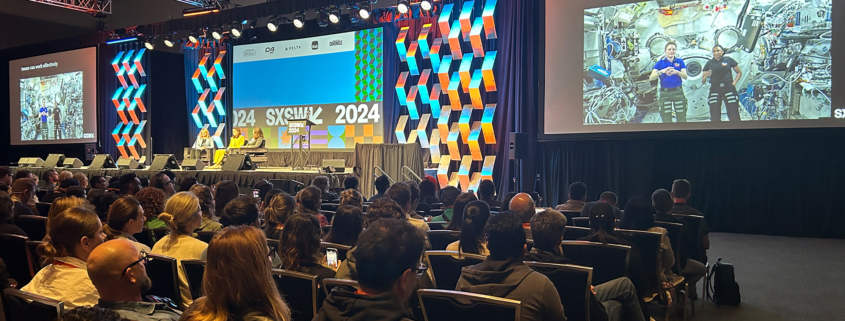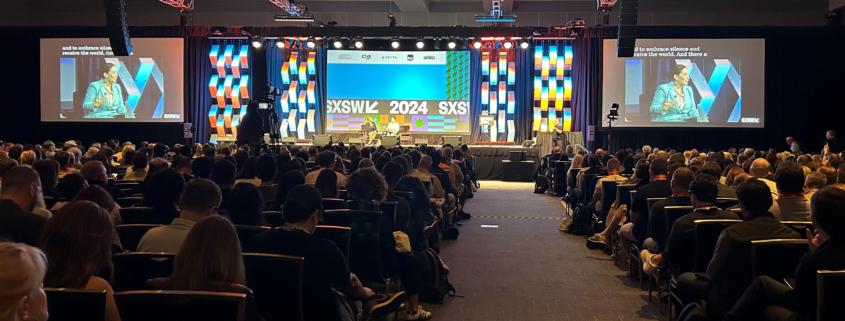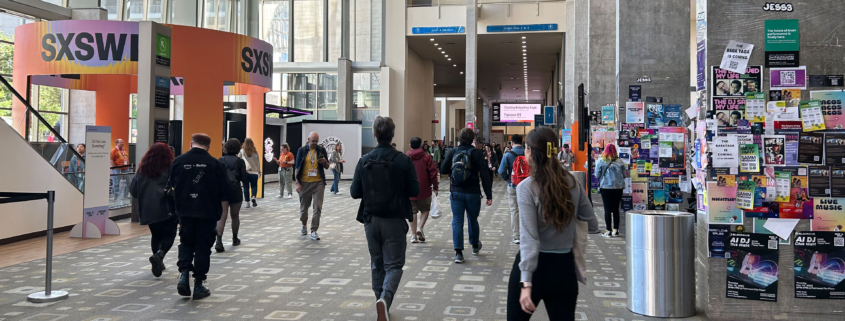One of the most fun things about SXSW is that even if you come for a specific type of insight – in our case, anything related to marketing, technology and (digital) culture – the sheer length of the conference allows you to see a lot of different things. Today, NASA hosted an entertaining opening session featuring an all-female panel of NASA scientists and two astronauts with a live video feed from the ISS – there are certainly less inspiring ways to start the day.
Future Consumers
More down-to-earth in the truest sense of the word, but no less insightful, was a session hosted by Joëlle de Montgolfier and Leah Johns of Bain & Company, who took the audience through their Beyond Trends report. Against the backdrop of our rapidly changing society, driven on the one hand by technological breakthroughs and, on the other, by the ecological shifts brought about by climate change, they outlined eight longer-term shifts in consumer behaviour at macro and micro levels; as well as possible solutions for how business leaders can and should respond.
- Global and local migration will drastically change our cities and living spaces and requires new ways of thinking about the digitalization of essential services such as healthcare or the automation of retail spaces.
- The Ageing of societies and the decline of the nuclear family as the dominant social structure in Western societies will lead to various new services for the older, yet active part of the population in the fields of leisure, work, and education. But much of the infrastructure designed around the nuclear family will also have to change, from transport to restaurants and shopping.
- With an ageing workforce and a much greater willingness of younger generations to change careers, new working models will need to be developed.
- A steadily growing part of society is becoming more eco-conscious, which is having a dramatic impact on consumption. There’s a stronger focus on DIY and reducing the carbon footprint of travel. Avoiding unnecessary purchases is also a challenge for existing goods and services.
- With advances in AI and robotics, there is a growing appetite to automate mundane tasks with technology.
- Consumers of the future will also think differently about health, heavily influenced by the technology available to them – from wearables to track fitness, to ways and means to improve health, performance, and ageing, there’s a wealth of new business opportunities to be found.
- Last but not least, emotional support and well-being is becoming a key challenge for our societies as loneliness increases and shared rituals and places of community decline. New sources of companionship and happiness in services and goods can play a key role in solving this issue.
Designing for tomorrow’s consumers
Jake Brody from Accenture Song took the stage on Tuesday afternoon to outline five trends in designing brand communication in a rapidly changing environment, affected by economic uncertainty, social strife, new technologies and climate change.
Economic challenges have led many brands to increase prices, often in non-transparent ways – from shrinkflation, to reducing product or service quality – leading consumers to fall out of love with their favourite brands. Regaining consumer trust and providing value, while carefully balancing cost reduction, will be a key challenge for marketing. One possible solution: AI.
Generative AI will have a drastic influence on every consumer-brand interface. Marketers must figure out ways to preserve their brands’ identities while relying heavily on AI-powered hyper-personalisation, which increases consumer satisfaction through a higher level of feeling understood and cared for.
Further relying on the latest technological advances comes with its own set of challenges. Especially as consumers grow increasingly weary of the fast-moving tech hypes, from metaverse to AI to spatial computing. Changes feel too fast and people fear that technology isn’t always beneficial to their wellbeing. For marketers, this means putting the consumer’s best interests first when deciding which technologies to implement in communications and brand experiences.
Another interesting point raised by Brody: Audiences as well as creators and creatives, are becoming increasingly bored and limited by the prevalence of efficiency-driven content and creation. Consumers feel everything looks and feels the same – a dangerous path for brands that lose their ability to differentiate themselves. One possible solution is to set aside what Brody calls a lunacy budget for risky and creative endeavours that spark curiosity and excitement.
Introducing Generation Alpha
Discussing the future consumer inevitably leads us to Generation Alpha, the emerging key audience born between 2013 and 2024. Joanna Piacenza of Morning Consult offered compelling insights into this very young audience group, highlighting the profound influence of their millennial parents’ experiences. From economic recessions to a global pandemic and the digital revolution: Gen Alpha is being raised during many once-in-a-lifetime events that heavily influence their upbringing. Their parents are shaping a new generation with strikingly different characteristics from previous generations.
Interesting from a marketing point of view: Gen Alpha develops brand loyalty from a very young age, especially for groceries, snacks and entertainment programmes. This demonstrates their strong influence on decisions within the family dynamic, as they are actively involved in the decision-making process by their parents. This influence even extends to travelling to a destination that the child has seen, for example, on TV. Raised by financially cautious parents (who often openly discuss their household finances with their children), Gen Alpha shows early digital and financial savviness as well as brand consciousness. With a widespread use of tablets and an emerging interest in VR (49% of Gen Alphas own a tablet while 12% already own a VR set), digital immersion is in their DNA.
For brands, connecting with Gen Alpha is challenging and requires an understanding of their digital-first nature and the values they have received from their millennial parents. Early involvement in decision-making means Alphas will have strong opinions, from societal topics to brands. Alpha’s online habits are being formed now, and the habits they form are likely to stay with them for a long time. Acknowledging this dynamic is essential for brands to develop strategies that truly resonate with this emerging audience.
This article was first published on Horizont.



